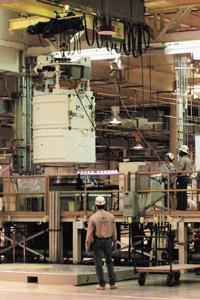Radiation Basics
The nucleus of the atom is formed by positively charged neutrons and protons. Their stability depends on the number of protons and neutrons, and the division between them. A chemical element can contain several isotopes, with different quantities and divisions, such as uranium 235 and 238 (both have the same number of protons, 92, since the number of protons defines the chemical element, but the first has 143 neutrons and the second 146, and are written as: 23592U first and 23892U second. Unstable isotopes disintegrate by emitting alpha, beta, or gamma rays.
- Alpha helium particlesare the cores of tomato. Its charge is +2 (two protons) and its mass moves with great energy (two protons plus 2 neutrons). Being in the air they will circulate an average distance of 4.5 cm. and only a few micrometers in the body, but yes, they ionize everything they find on the way. Alpha particles will not pass through the normal role or skin of the body, so they are not dangerous if they are outside the body, but they are very dangerous to cause cancer if they enter the body through the nose or mouth.

- Beta particles are electrons, have a load of -1 (an electron) and a very small mass. Beta particles can travel a few meters in the air or a few centimeters in our body. They cannot cross the window glass or escape the steel tank. These are also dangerous if they enter the body, as they can ionize anything that collides, but they are not as dangerous as alpha particles.
- gamma rays have a 0 mass and a 0 load, but great energies. Like high-energy x-rays, large roofs are needed to protect them, i.e. concrete, lead or water.
In high-activity residues gamma ray radiation is very high. But only a small group of transuranic waste emits an obvious beta or gamma radiation; they are the alpha-emitters.
The disintegration of radioactive samples is statistical and it is impossible to predict when a specific atom disintegrates. What we can predict is the time that must pass in a radioactive sample of unstable atoms of the same type to disintegrate half of these unstable atoms. This time interval is called semivesity (T1/2).
- Activity (A) represents the rate of disintegration (number of disintegrations occurred in a second) and is proportional to the number of unstable cores. Activity decreases exponentially over time according to the following law: A = A0e-lt, where l is proportional to the inverse of the semi-life (A = activity in the instant t, A0 activity in the initial instant). The longer the half-life, the activity of this radioactive nucleus will decrease more slowly. Plutonium 239, a widespread alpha emitter among waste, has an average life of 24,000 years and the time required for activity to be halved. If the average life is very short, the activity of this core will be reduced quickly.
- Units:
1 Bq (becquerel) = 1 disintegration/s
1 Ci (curie) = 3.7 x 1010 Bq
- Fission reaction: division of a nucleus by neutron trapping, for example
23592U + 10n > 13552Te + 9740Zr + 4 in 10
235The previous reaction indicates that by catching a neutron (10n) the uranium can be divided into two fractions, one of 135 La del teluro and another of 97Zirconium, in which 4 other neutrons are released. Normally these neutrons will be lost without causing any effect, but if the amount (mass) of 235 Uranium is evident, it may occur that one of the released neutrons is trapped and another fission occurs, continuing the fission reaction. The minimum mass of fissionable nucleus needed to maintain the fission reaction continuously is called critical mass. If the amount of mass is lower, the reaction is sub-critical and the speed of the fission reactions decreases; if the amount of mass is greater than the criticism, the reaction is supercritical and the number of fission reactions increases (releasing a lot of energy). Therefore, the fissionable waste deposited in the tanks must be in sub-critical quantities.





